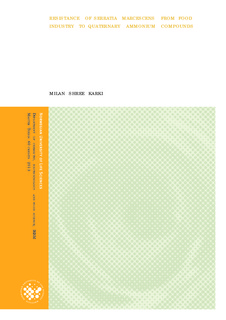| dc.description.abstract | In earlier days, antibiotic resistance was more concern than disinfectant resistance. During the last 20 years there has also been a focus on disinfectant resistance because of fear that wide spread used of disinfectant in any of the settings hospital, food industry may overall contributes for resistance to antibiotics. The aim of the study is to elucidate the mechanism of resistance to quaternary ammonium compounds, a group of disinfectants, among Serratia marcescens from the food industry. In this study we determined the minimum inhibitory concentration (MIC) and bactericidal value for 13 Serratia marcescens strains isolated from the food industry and two laboratory strains of Serratia marcescens with two quaternary ammonium compounds Benzalkonium chloride (BAC) and Cetyl Pyridimine Chloride (CPC). Strains from food industry were resistant having less than 3 log10 reduction on the Bactericidal test whereas laboratory strains has more than 5 log10 reduction. One of the laboratory strains was sensitive to CPC in the MIC test, while the other was sensitive to BAC. The laboratory strains were adapted to higher concentration as footbath strain by serially subculturing them in increasing concentration up to 200 ppm.
Serratia marcescens has been reported to gain resistance to QACs by expression of sdeAB efflux pumps, due to mutation in sdeS, a gene encoding the repressor protein sdeS. In our study we sequenced sdeS and found that there were 11 nucleotide substitutions on the sdeS gene between sensitive and adapted/resistant strains. These substitutions refer to two amino acid substitutions in the putative sdeS proteins common in all the strains (adapted and resistant) at position 157 and 159 from threonine to alanine and aspartic acid to glycine respectively. Besides this there was insertion of glutamine in position 153 in all the adapted strains and two footbath strains. Since the amino acid substitutions were found in all strains, this indicates the sdeS may be involve in resistance, however further studies is needed in order to prove this.
Biocide resistance confers a biological cost. We observe that BAC adapted strains exhibited a fitness cost, having reduced growth rate; there was significant difference on the growth rate (p<0.05). Strains lost its acquired adaptation, in our study also from 17 up to 85 percentages of adapted strains lose its acquired resistance after ten cultivation in media without quaternary ammonium compounds.
PCR revealed that all tested strains contained the gene for efflux pumps (sdeAB, sdeXY, sdeCDE).
In conclusion the work in thesis showed that Serratia marcescens from the food industry have common mutation in the sdeS gene. Further studies are necessary in order to elucidate the resistance mechanism. Resistance to QAC is not a stable trait. The presence of resistant strains in the food industry, indicate that the use of QAC in the food industry selects for QAC resistance Serratia marcescens. | no_NO |
